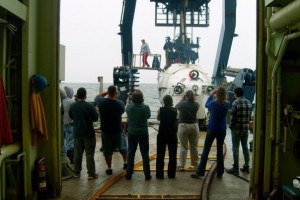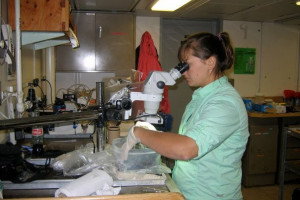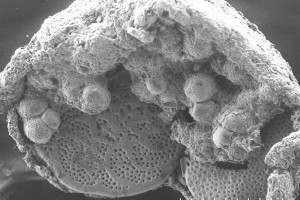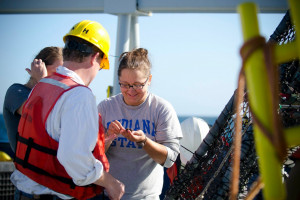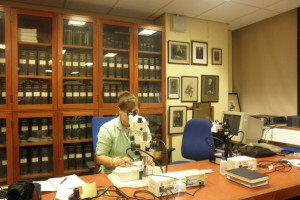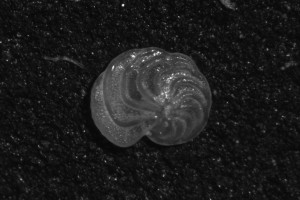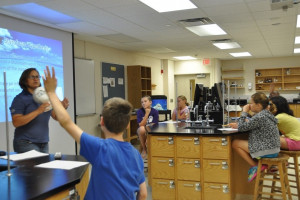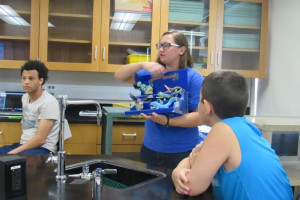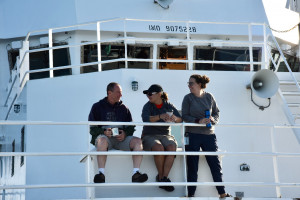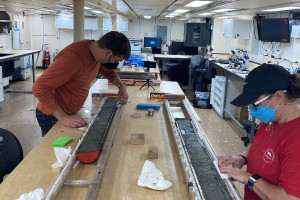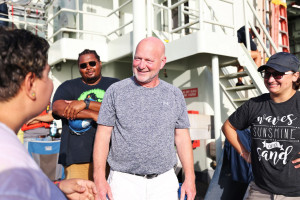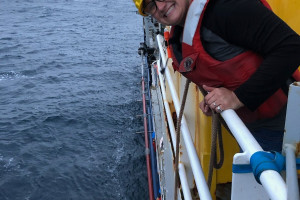 Dr. Ashley M. Burkett
Dr. Ashley M. Burkett
Primary Research Topics
MicroCT imaging- My interests in MicroCT technology revolve around my expertise as a micropaleontologist. I’m interested in using MicroCT scanning in my work on modern analogs to develop a paleooxygen proxy to better interpret, and ideally even quantify, oxygen availability in the oceans of the Earth’s past. I am also interested in using MicroCT scanning technology to better understand several unknown mechanisms of foraminifera lifespan, mobility, and reproduction. Finally, I am very excited about the prospects of microfossil reconstructions when applied to machine learning. Some of our 3D models can be found on sketchfab.com/OSUDr.B
Low oxygen and high organic environments- I am interested in the development of proxies to determine oxygen availability and assess the quality and extent of organic carbon in past marine environments. I am interested in looking at microfossil records in low oxygen/high organic carbon environments to assess ecologic and morphologic shifts (visible via SEM and MicroCT) indicative of changes in oxygen/carbon and coupling these records with sediment and biogeochemistry to explore, generate and refine geochemical and foraminiferal morphologic methods for quantifying oxygen/organic carbon availability.
Microfossil biogeochemistry- Marine microfossils can serve as a geochemical archive of the environments in which they formed their skeletal structures. I am interested in using precise analytical equipment such as Laser Ablation and Secondary Ion Mass Spectrometry to assess biogeochemical records (d18O, d 13C and a variety of trace elements). In addition to low oxygen environments, I am also especially interested in using these approaches to assess the origin, location, and timing of methane seepage.
Biostratigraphy and Basin Analysis- Microfossils are an excellent biostratigraphic tool that and can also provide valuable information about environmental conditions (e.g., water depth, temperature, etc.) during deposition.
Involvement at OSU
- OPENOKstate Fellow
- OSU Arts and Sciences Faculty Spotlight article!
- Avid fan of the Faculy Reads Education and Diversity series!
Publications
- 2020. Burkett, A.M., Rathburn, A.E., Pratt, R.B., Holzmann. Insights into the Ecology of Epibenthic Calcareous Foraminifera from a Colonization Study at 4100m (Station M) in the NE Pacific Ocean. Deep Sea Research Part II: Topical Studies in Oceanography, 173, 104709.
- 2020. Wanyi L., Rickaby, R.E.M., Hoogakker, B.A.A., Rathburn, A.E., Burkett, A.M., Dickson, A.J., Martínez-Méndez, G., Hillenbrand, C.D., Zhou, X., Thomas, E., Lu, Z. I/Ca in epifaunal benthic foraminifera: a semi-quantitative proxy for bottom water oxygen used in a multi-proxy compilation for glacial ocean deoxygenation. Earth and Planetary Science Letters, 533, 116055.
- 2018. Venturelli, R.A., Rathburn, A.E., Burkett, A.M., Ziebis, W., Corliss, B.H. Epifaunal foraminifera in an Infaunal World: Insights into the influence of Heterogeneity on the Benthic Ecology of Oxygen-Poor, Deep-Sea Habitats. Frontiers in Marine Science.
- 2018. Rathburn, A.E., Willingham, J., Ziebis, W., Burkett, A.M., Corliss, B.H. A biological proxy for paleo-oxygen levels in deep-sea bottom waters: Pores of epifaunal deep-sea benthic foraminifera. Scientific Reports (Nature).
- 2018. Burkett, A.M., Rathburn, A.E., Pérez, M.E., Martin, J., Levin, L. A., Influences of thermal and fluid characteristics of methane and hydrothermal seeps on the stable oxygen isotopes of living benthic foraminifera. Marine and Petroleum Geology.
- 2016. Burkett, A.M., Rathburn, A.E., Pérez, M.E., Martin, J., Levin, L.A. Colonization of over a thousand Cibicidoides wuellerstorfi (foraminifera; Schwager, 1866) on artificial substrates in seep and adjacent off-seep locations in dysoxic, deep-sea environments. Deep-Sea Research I: Oceanographic Research Papers ,117: 39-50.
- 2015. Burkett, A.M., Rathburn, A.E., Pérez, M.E., Martin, J., Levin, L.A., Cha, H., Rouse, G.W. Phylogenetic placement of epibenthic foraminifera Cibicidoides wuellerstorfi (Schwager, 1886) from methane seeps and non-seeps habitats on the Pacific margin. Geobiology. DOI: 10.1111/gbi.12118
- 2014. Parsons-Hubbard, K., Hubbard, *D., Tems, C., Burkett, A.M. "The Relationship Between Modern Mollusk Assemblages and Their Expression in Subsurface Sediment in a Carbonate Lagoon, St. Croix, US Virgin Islands." Approaches to Understanding Fossil Organisms. Springer Science & Business Media Dordrecht.
- 2013. Harris, R.N., Sakaguchi, A., Petronotis, K., Baxter, A.T., Berg, R., Burkett, A.M., and others. "Expedition 344 summary." IODP| Volume. Vol. 344.
- 2013. Harris, R.N., Sakaguchi, A., Petronotis, K., Baxter, A.T., Berg, R., Burkett, A.M., and others. "Input Site U1414." IODP| Volume. Vol. 344.
- 2013. Harris, R.N., Sakaguchi, A., Petronotis, K., Baxter, A.T., Berg, R., Burkett, A.M., and others. "Input Site U1381." IODP| Volume. Vol. 344. 2013.
- 2013. Harris, R.N., Sakaguchi, A., Petronotis, K., Baxter, A.T., Berg, R., Burkett, A.M., and others.. "Frontal prism Site U1412." IODP| Volume. Vol. 344.
Teaching
I am a teacher who is passionate about having students participate in a variety of engaging and hands-on learning activities. I have taught Introductory Geology courses at three Universities and teach the following at OSU. In 2021 I recieved the College of Arts and Sciences Excellence in Undergraduate Teaching Award.
- GEOL 1003: The Story of Dinosaurs (non-major, no-science pre-req Undergraduates) This course is targeted at fostering and facilitating critical thinking and scientific literacy through the exploration of Dinosaur research and interpretations.
- GEOL 1224: Evolution of the Earth (for Undergraduate Students)
- GEOL 3103 Paleontology (for Undergraduate Students)
- GEOL 5183: Paleontology of Depositional Sequences (for Graduate Students)
Future Students
I am always interested in talking to students about potential research project. Please contact me directly to inquire about potential funding opportuinites.
If you are an OSU undergraduate interested in a research or capstone project come to see me in 103C of Noble Research Center as soon as you can. I am interested in having these students explore the dynamics of foraminiferal morphology, ecology, and phylogeny to develop key proxies essential to the interpretations of past oxygen availability.
IIf you are interested in joining the lab please contact Dr. Burkett directly at: ashley.burkett@okstate.edu and check out the deadlines for the OSU graduate college.
For more information click here

